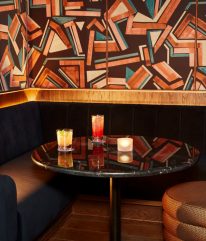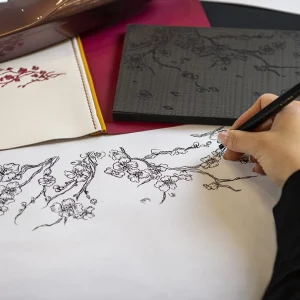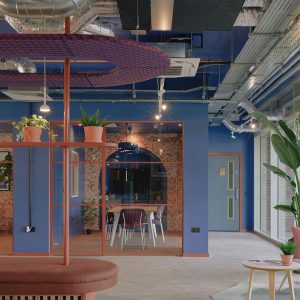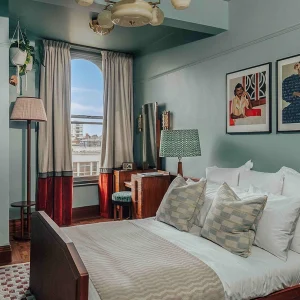
Words By Emily Martin
Images By Ennismore
PROJECT INFO
Client Ennismore
Interior design Studio Moren www.studiomoren.co.uk
Size 111 guestrooms
Completion September 2024
Studio Moren has brought a Grade II listed City of London landmark back to life as a new lifestyle hotel and restaurant destination. The former Spiers and Pond hotel – located at 15 Old Bailey – has been transformed into Ennismore’s Hyde London City hotel, Leydi restaurant, and the underground speakeasy Black Lacquer.
Studio Moren’s design concept pays homage to the rich history of the building first built in 1874, which spans generations and is set within one of the most storied neighbourhoods of the capital. The hotel, with 111 guestrooms, features three destinations within one building, delivered together as a coherent collective.
Tom Thorogood, co-head of interiors at Studio Moren, says: ‘We have embraced the design challenge of incorporating the building’s rich history and architectural nuances whilst celebrating the contemporary vibrancy of the Hyde lifestyle brand at its first UK outpost, using our experience in luxury hospitality to elevate the guest experience.’

At ground level, its restaurant – Leydi – offers celebratory Turkish food, with its design referencing the spirit of Istanbul. It features dramatic design flourishes, including arched passages, pendant lighting and extensive planting. In response to Ennismore’s brief to create an experience that celebrates food and encourages guest and kitchen connection, the open kitchen adds a sense of theatre and activates the space. The walls give warmth with gradient texture, a bespoke blush plaster finish, and an eclectic artwork collection. Further texture is achieved through rattan features across banquette seating, the wine display, and wait stations. Bespoke lighting includes a statement chandelier – a modern take on a traditional chandelier as a nod to the hotel’s history.

A subterranean cocktail bar, Black Lacquer, draws its inspiration in concept and name from vinyl records. The refined Japanese aesthetic of this space is informed by Tokyo’s music cultural scene with its famous ‘listening bars’. Here, its moody and intimate feel is achieved through dark upholstery and midnight blue wall finishes. Design details include polished plaster walls with grooves inspired by the music patterns on vinyl records, and the single-level bar enhances the connection between mixologist and guest, providing a sense of theatre to the art of cocktail making. The space includes three alcoves for intimate conversations, lit only by candlelight. Bespoke design is in abundance, from the curvilinear burnt orange bar stools to the high-level shelving that houses the vinyl record collection, wrapping the perimeter of the room.

For those staying the night, guestrooms alternate between deep green and blue colour schemes, staying true to a Victorian palette. There are maximalist wallpapers by Timorous Beasties celebrating aspects of 19th-century Britain, taking inspiration from the drama of nature as discovered by explorers and botanists, and the mesmerising patterns seen through a kaleidoscope – a fascination prevalent during the turn of the Victorian era. Within the hotel’s suite, wallpaper from House of Hackney features a heady design of lush palm leaves.
Studio Moren’s scheme design features bespoke furniture throughout, detailing unusual forms and elegant dovetail joinery techniques, and an illuminated sleeping face playfully takes the place of traditional ‘Do Not Disturb’ signs.

At ground floor level, the studio’s use of creative use of space planning provides a distinct change of feel as hotel guests move from the lobby to the restaurant beyond. The bar, a statement piece with its bespoke marble inlay, cleverly separates the two spaces and creates a welcoming spot to linger.

Externally, the property remains characterised by its grandeur and opulence, with ornate details such as mansard roofs, elaborate mouldings, and decorative columns. Starting life as a hotel – said to be the first in London to feature electric lighting – the building was most recently used as offices. It was a 1980s internal reconstruction that diluted the property’s Victorian charm. The challenge for Studio Moren was to reinstate elements of historic design within its interiors, adapting to the needs and taste of the contemporary guest.

The team reintroduced architectural details of the Victorian era such as cornicing, high skirtings and timber flooring to work cohesively with new, bespoke joinery pieces.

Another key architectural challenge for the team was to harmoniously build an extension over an existing lightwell at the rear of the building, paying homage to the original building in appearance, and enabling the addition of 21 guestrooms to the property’s key count.

Ed Murray, associate at Studio Moren, says: ‘This project has been a gift in the way in which we have been able to embrace the building’s incredible history through our transformation of its architecture and interior design. Its transformation brings the property back to its original purpose, providing a positive contribution to the City of London and London’s wider hospitality sector, and we look forward to seeing it enjoyed by guests once again.’
KEY SUPPLIERS
Surfaces
Timorous Beasties
House of Hackney
Crest Leather
Alma Leather
Clarke & Clarke clarke-clarke.
Casamance





